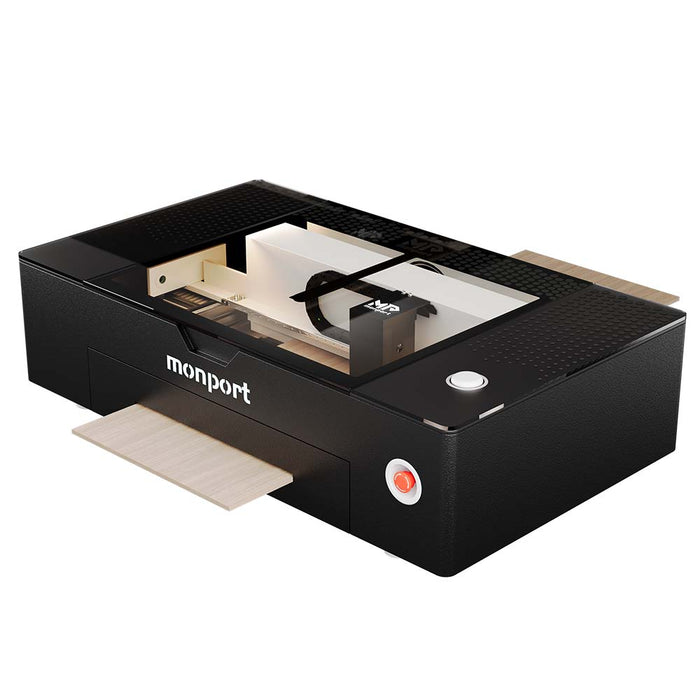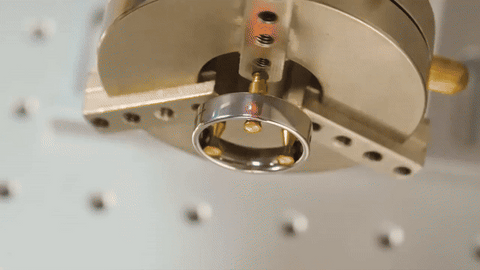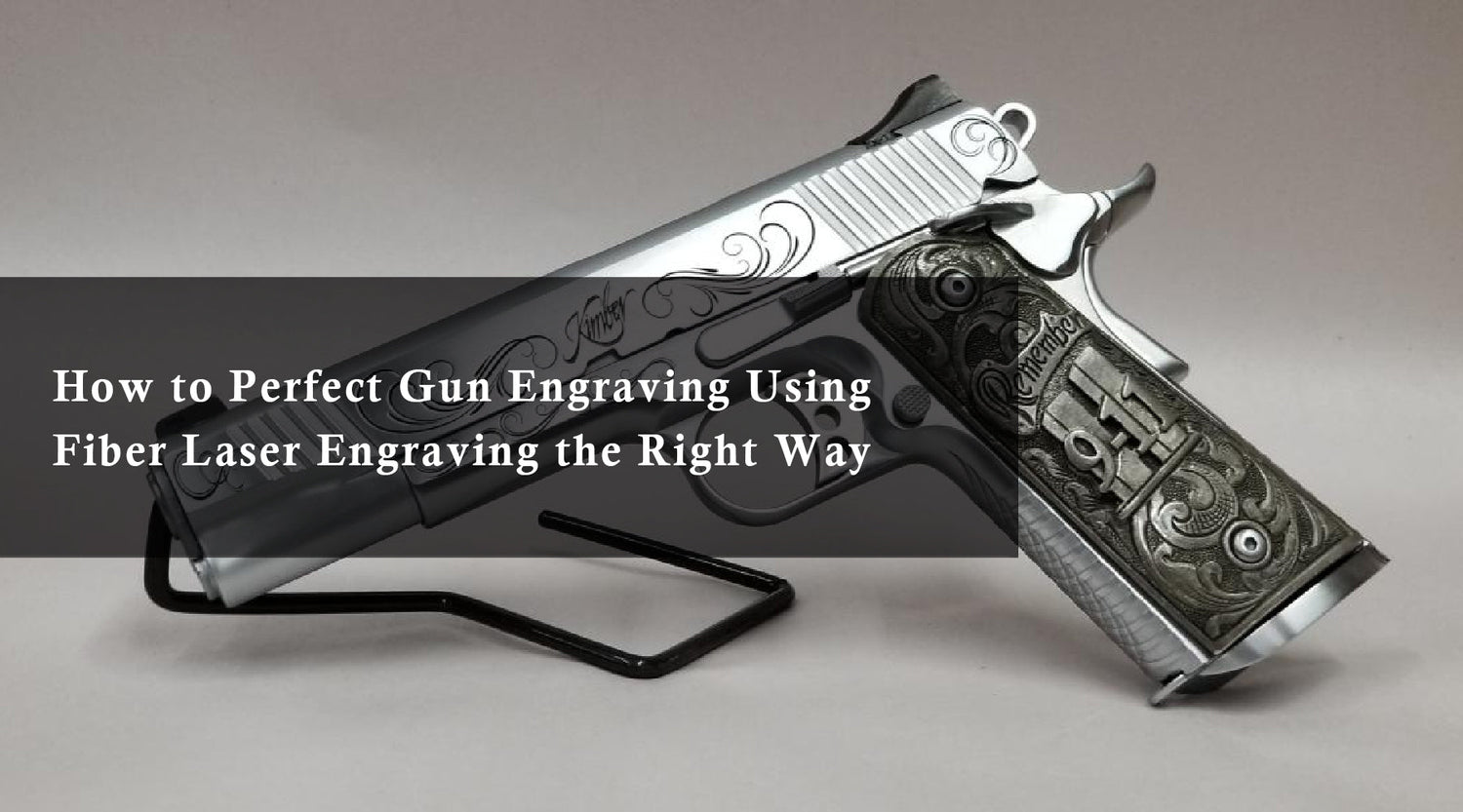Laser cutting technology has revolutionized manufacturing and fabrication, offering unparalleled precision, speed, and versatility. But with two prominent players in the field – fiber laser cutting vs CO2 laser – choosing the right tool can be overwhelming. This guide explores the difference between CO2 and fiber laser cutting, equipping you with the knowledge to make an informed decision for your specific needs.
Many businesses search for co2 vs fiber laser comparisons to understand which option suits their production requirements best.
| Machine Image |  |
 |
||||
| CO2 Laser Model | Monport 80W CO2 Laser | Monport 100W CO2 Laser | Monport 130W CO2 Laser | Monport Onyx 55W Desktop CO2 Laser | Monport 40w Pro CO2 Laser |
| Machine Image |  |
||||
| Fiber Laser Model | GPro Series MOPA | GA Series MOPA | GQ Series Machine | GP Series Machine | GI Series MOPA |
Unveiling the Technology: Fiber Laser Cutting vs CO2 Lasers
CO2 Lasers:

- Technology: CO2 lasers utilize a mixture of carbon dioxide (CO2), helium, and nitrogen gases to generate a laser beam.
-
Wavelength: CO2 lasers operate at a wavelength of around 10.6 micrometers (µm). This wavelength is readily absorbed by organic materials like wood, acrylic, plastic, and fabric. For many industries, comparing co2 vs fiber laser performance at this stage highlights the wavelength difference.
Fiber Lasers:

-
Fiber Lasers: Fiber lasers reign supreme in metal cutting applications. Their shorter wavelength offers excellent reflectivity on metals, allowing for precise, high-quality cuts on a wide range of metals, including steel, stainless steel, aluminum, brass, and copper. That’s why co2 vs fiber laser often becomes a metals vs non-metals debate.
- Wavelength: Fiber lasers typically operate at a much shorter wavelength, around 1.06 µm. This wavelength offers superior reflective properties for metals, giving fiber laser cutting an edge in handling challenging materials.
Key Considerations: Difference Between CO2 and Fiber Laser Cutting
Here's a breakdown of some key factors to consider when comparing the difference between CO2 and fiber laser cutting:
Material Compatibility:

- CO2 Lasers: CO2 lasers excel at cutting non-metals like wood, acrylic, plastic, fabric, rubber, and leather. Their longer wavelength is efficiently absorbed by these organic materials, resulting in clean cuts.

- Fiber Lasers: Fiber lasers reign supreme in metal cutting applications. Their shorter wavelength offers excellent reflectivity on metals, allowing for precise, high-quality cuts on a wide range of metals, including steel, stainless steel, aluminum, brass, and copper.
Cutting Speed and Power:
- CO2 Lasers: CO2 lasers generally offer slower cutting speeds compared to fiber lasers, particularly when cutting thicker materials.
- Fiber Lasers: Fiber lasers boast superior cutting speeds across various metal thicknesses. Their high beam quality translates to faster cutting times and cleaner edges.
Maintenance:
- CO2 Lasers: CO2 lasers require regular maintenance, including gas replacements and alignment checks.
- Fiber Lasers: Fiber lasers are known for their low maintenance requirements. They offer a longer lifespan for the laser source and require minimal adjustments.
Energy Consumption:
- CO2 Lasers: CO2 lasers typically consume more energy compared to fiber lasers to achieve the same cutting power.
- Fiber Lasers: Fiber lasers offer superior energy efficiency, translating to lower operating costs over time.
Cost:
- CO2 Lasers: CO2 lasers are generally more affordable upfront compared to fiber lasers.
-
Fiber Lasers: While the initial investment for fiber lasers might be higher, their lower operating costs, faster cutting speeds, and minimal maintenance requirements can lead to significant cost savings in the long run. In long-term co2 vs fiber laser debates, cost efficiency often tilts the scale toward fiber.
Finding the Perfect Fit: Monport Laser CO2 and Fiber Engravers
Monport Laser offers a versatile range of CO2 and fiber laser engravers to cater to your specific needs. Here's a glimpse into some of their offerings:
-
Monport CO2 Lasers:
- ONYX 55W Desktop CO2 Laser: This user-friendly CO2 laser boasts a powerful 55W laser tube, making it ideal for various engraving and cutting projects on non-metallic materials.
- Mobility Protrude CO2 Laser: Designed for portability, this CO2 laser is perfect for on-site applications and offers precise engraving on a range of materials.
- Built-in Chiller CO2 Laser: This CO2 laser features an integrated chiller for optimal temperature control, ensuring consistent performance during intensive projects.
- 40w Desktop CO2 Laser: A budget-friendly option, this 40W CO2 laser is perfect for hobbyists and small businesses, offering exceptional engraving capabilities on non-metals.
-
Monport Fiber Lasers:
- GPro MOPA Fiber Laser: This versatile fiber laser delivers exceptional cutting performance on a wide range of metals, making it ideal for demanding industrial applications.
- GA MOPA Fiber Laser: Offering high-precision cutting capabilities, this fiber laser is perfect for intricate metalwork projects.
- GQ Fiber Laser: The GQ Fiber Laser provides excellent cutting speed and power, making it a strong choice for high-volume metal fabrication.
- GP Fiber Laser: This user-friendly fiber laser is ideal for beginners and professionals alike, offering precise metal cutting with a user-intuitive interface.
- GI Fiber Laser: The GI Fiber Laser boasts a large working area, perfect for handling oversized metal sheets with exceptional cutting quality.
Making the Choice: Fiber Laser Cutting vs CO2 Laser
Ultimately, the best choice between a CO2 and fiber laser cutter hinges on your specific project requirements:

- For cutting non-metals such as wood, acrylic, plastic, and fabric, a CO2 laser offers a cost-effective and versatile solution.

- For cutting metals such as steel, stainless steel, aluminum, and brass, a fiber laser is the clear winner, providing superior cutting speed, precision, and reflectivity on these materials.
Additional Considerations:
-
Project Volume: If you anticipate high-volume production runs, the faster cutting speeds and lower operating costs of a fiber laser may justify the higher upfront investment. In co2 vs fiber laser comparisons, production scale is a vital factor.
- Material Thickness: While both CO2 and fiber lasers can handle various material thicknesses, fiber lasers generally excel at cutting thicker metals with clean edges.
- Maintenance Needs: If ease of maintenance is a priority, the lower maintenance requirements of a fiber laser may be a significant advantage.
Beyond the Basics: Applications and Advantages
CO2 Laser Applications:
- Signage and displays
- Awards and trophies
- Packaging prototypes
- Promotional products
- Arts and crafts
Advantages of CO2 Lasers:
- Affordable upfront cost
- Versatile material compatibility
- Excellent for detailed engraving on non-metals
Fiber Laser Applications:

- Jewelry making
- Sheet metal fabrication
- Automotive parts manufacturing
- Electronics manufacturing
- Medical device manufacturing
Advantages of Fiber Lasers:
- Superior cutting speed and precision on metals
- High beam quality for clean edges
- Low maintenance requirements
- Energy efficiency
The Future of Laser Cutting
Both CO2 and fiber laser cutting technologies continue to evolve, offering increasing power, speed, and efficiency. Here at Monport Laser, we are dedicated to staying at the forefront of laser technology, providing innovative and reliable CO2 and fiber laser solutions for your cutting and engraving needs. In the co2 vs fiber laser race, both technologies are advancing rapidly.
Remember: When selecting a laser cutter, carefully evaluate your project requirements, budget, and material needs. By understanding the difference between CO2 and fiber laser cutting, you can make an informed decision and unlock the vast creative and production possibilities of laser technology.
Contact Monport Laser today to explore our extensive range of CO2 and fiber laser engravers and cutting machines. Our knowledgeable team is happy to assist you in finding the perfect laser solution to bring your vision to life.















